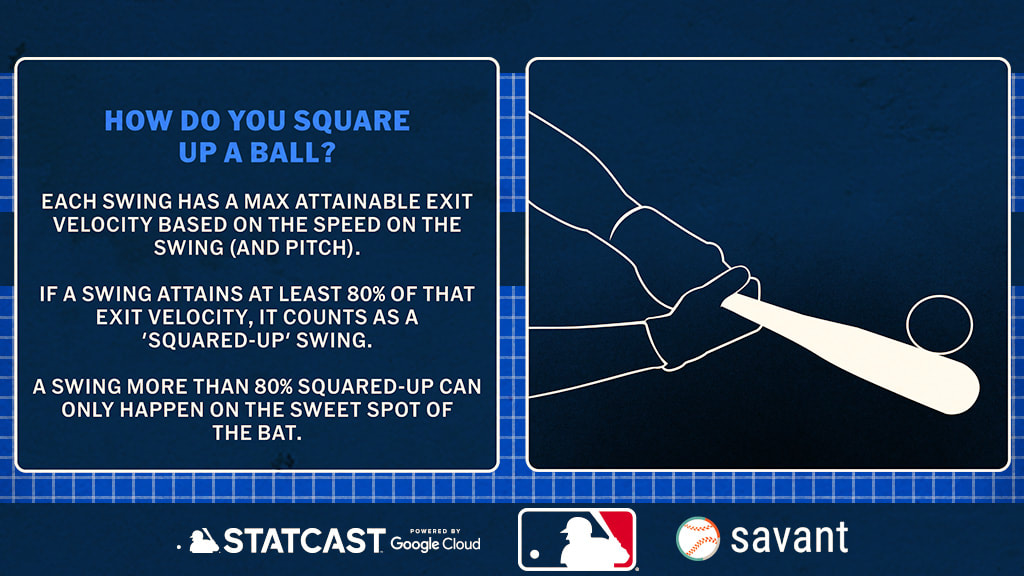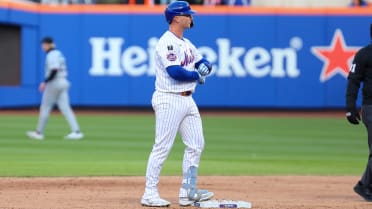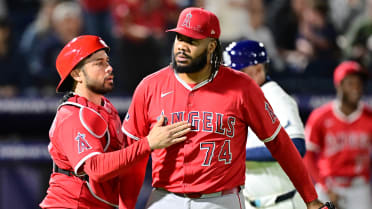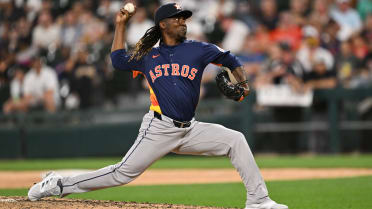“The whole premise of pitching is to keep the ball off the barrel,” 13-year veteran pitcher Wade LeBlanc said to Japanese media in 2016, as he was finishing up a stint with the Saitama Seibu Lions. “To keep guys from hitting the ball hard. It's not necessarily [to] strike everybody out. For a lack of better words, it's to keep guys from hitting the ball hard."
Well, sure. That’s something pitchers have been trying to do for a century, and that’s something we’ve been able to quantify – via hard-hit rate, and just simply slugging percentage before that – in various ways for many years now.
But, with the advent of Statcast’s new bat-tracking metrics, there’s a new way to look at it, too. While the majority of the new data has focused on the batter – they are, after all, the ones holding the bat – there’s an interesting angle for pitchers here, too. Which pitchers this season are doing the best at preventing their opponents from squaring up the ball?
While average bat speed against pitchers doesn’t mean a whole lot – there’s hardly any good-to-bad spread there, because it’s not something pitchers have much control over – a low squared-up rate should mean, in theory, that you’re doing something to prevent the batter from making his most solid contact. A squared-up swing is one where a batter accesses at least 80% of the available exit velocity given the speed of the swing and the pitch, and that can really only be done if you hit the ball on the fat part of the bat.

If, as a pitcher, you’re ensuring the opposing batter isn’t doing that, it probably means you’re doing something right. Maybe that’s deception, or location, or sequencing, or pure nasty stuff. Maybe it’s all of it. It means a lot, too, because look at the difference in outcomes on contact that is squared up, compared with contact that isn't.
- Squared-up swings: .369/.649 AVG/SLG (57% hard-hit rate)
- Not squared-up swings: .203/.229 AVG/SLG (0.3% hard-hit rate)
Pretty big difference, right? And right now, the batter squared-up leaderboard is topped by Luis Arraez and Mookie Betts, whom you might consider to be a pair of excellent hitters. So instead, let’s talk about the pitchers who aren’t allowing it, because if you look at the ones who are allowing a high squared-up rate, it’s mostly a list of pitchers not having good seasons.
After all, as Charlie Morton said back in 2016, when asked about his pitching strategy: "If I can keep the ball off the barrel, I think that would be the short answer. Keep the ball off the barrel and get weak contact." Morton, still going strong at age 40, has a slightly better than average squared-up rate.
With a minimum of 200 competitive swings against, 2024’s 10 best preventers of squared-up contact (entering Monday) are …
BONUS: Mason Miller, A's (13% of swings)
We’re already cheating, because Miller has only 168 competitive swings against, and therefore does not qualify for our list. But because he’s been so incredibly good this year, we thought it was worth pointing out here that it’s not just about the 50% (!) strikeout rate. It’s about the fact that even when contact is made, it’s mostly weak, inefficient contact. (Another way to think about this: 87% of the time a hitter swings, he fails to square it up.)
1. Kyle Bradish, Orioles (17%)
Bradish, one of last year’s breakout pitching stars, started his season late due to a UCL sprain, and all he’s done since is throw 34 1/3 innings without allowing a single home run. While that obviously won’t last, it’s also the first time since 1989 that an O’s starter began his season with at least 30 innings over seven starts without allowing a dinger. It’s not just about the extra-large left field in Camden Yards, either; for one thing, he’s been much better on the road, and for another, it’s really hard to allow a homer on a swing that isn’t squared up. (Only 15% of homers come on those swings.)
On Saturday, the Rays couldn’t even get a ball out of the infield against Bradish, as befitting a game where he allowed only four of 42 swings to be considered "squared-up." Bradish has raised his ground-ball rate and his popup rate; he’s cut his hard-hit rate more than any starter, and increased his strikeout rate more than any pitcher this side of Jack Flaherty. He’s also simply not allowing batters to get to anything like their best contact. It’s an essentially unbeatable combination.
2. MacKenzie Gore, Nationals (17.4%)
Gore was the No. 3 overall Draft pick back in 2017, but the prospect sheen had started to wear off a little by the time he was included in the first Juan Soto trade. Last year, he was a perfectly adequate member of the Washington rotation, though not terribly much more, in part due to a sky-high home run rate. This year, he’s cut that HR/9 rate in half – one of the largest improvements in baseball, actually – to go with one of the largest increases in fastball velocity. That fastball, which allowed 17 homers last year, has give up just three so far this season, along with a 90 point decrease in slugging percentage.
3. Freddy Peralta, Brewers (17.7%)
It’s too bad that bat-tracking data doesn’t go back earlier than 2024, because for parts of seven seasons, Peralta has been an “invisible” king, getting outstanding results with good-not-elite velocity, in large part because his elite extension and low release point make for a difficult viewpoint for a hitter to attack. So, while it’s true that Peralta is one of the most difficult pitchers to square up this season, what we can’t answer is whether that’s new – or if that’s just what he’s been doing for years. Our best guess: It’s the latter.
4. Reed Garrett, Mets (17.7%)
At 31 years old and with a career 7.11 ERA entering the season, it’s pretty safe to say that Garrett is maybe the least expected success story of 2024, mostly due to his two primary pitches. That would be his sweeper and splitter, which have combined to allow a mere .121 slugging percentage and 9% squared-up (per swing) rate, each elite. On the other hand, his two fastballs (four-seam and cutter) have allowed a massive 1.071 slugging percentage, and there are signs hitters are starting to key in on this – after starting the season by allowing two earned runs in his first 17 games, he’s allowed 10 in his last eight.
5. Garrett Crochet, White Sox (18.6%)
It now seems so long ago when we chuckled that the White Sox made Crochet one of the least-experienced Opening Day starters in history, because he has a shining bright spot in an otherwise forgettable Chicago season. (Especially so if you look past a late-April stumble; in his last nine starts, Crochet has allowed only 12 earned runs.) This is all in part due to a newly introduced cutter that’s become the primary complement to his four-seam, but also because the move from relief to rotation came without the usual drop in velocity that we’ve come to expect. When you’re striking out 34% of hitters, that’s a good way to avoid squared-up contact. Even accounting for that, however, Crochet is one of the hardest arms in the game to square up.
6. Michael King, Padres (19.3%)
This is our first perhaps somewhat-surprising entry on our list, because King, a huge part of the trade that sent Soto to New York, has been fine-not-great as a Padre, though he has followed up a 5.00 ERA in March/April with a 2.36 ERA in seven starts since, allowing only three homers in that time. Watch for increased usage of his changeup, which has gone from 15% usage last year to 25% this year – and is the second-most-difficult changeup to square up in the Majors.
7. Tyler Glasnow, Dodgers (19.6%)
This is a bigger achievement than it seems for Glasnow, who is a Cy Young Award contender in his first season with the Dodgers. No one, obviously, has ever doubted his talent or skill; it’s instead been his health that’s held him back. But last year with the Rays, he did have a bit of an issue with allowing loud contact, which has cleared up a little with the Dodgers. Again, we don’t have 2023 data to compare to, but Glasnow appearing on a list like this would seem like a good indication he’s found a way to keep hitters guessing enough to prevent that squared-up contact. Maybe it’s the new sinker.
8. Cole Ragans, Royals (19.7%)
Remember above, when we said King had the second-most-difficult changeup to square up? That’s only because Ragans’ change is first. The lefty's ascent from injury-prone Texas prospect to Kansas City ace has been well-documented, and what he’s done this year is to essentially back up the promise he showed in a dozen post-trade starts for the Royals last year. A big part of this story is in the slider he began to throw only after the trade, and he’s allowed just one home run off that pitch so far this season.
9. Zack Wheeler, Phillies (19.8%)
This shouldn’t be surprising, because Wheeler has been so good for so long that he leads all pitchers in Wins Above Replacement over the last seven years, and he’s got a 2.23 ERA this season. Of course this is a thing he should be good at. Right? Not that he needed any more weapons to make life difficult for hitters, but he re-introduced a splitter this year, and it’s merely his most difficult to square up pitch so far.
10. Kutter Crawford, Red Sox (19.9%)
An unheralded 16th-round pick back in 2017, Crawford seemed like a decent mid-rotation starter last year, then more than tripled his sweeper usage this season (among other changes) and has mostly shelved the curveball that got hit extremely hard in the past, leading to something of a mini-breakout. Watch his Tuesday night start against Wheeler and the Phillies closely though, because he was excellent at this in April, but has been more league-average ever since.
Mike Petriello is a stats analyst for MLB.com, focusing on Statcast and Baseball Savant, and is also a contributor to MLB Network.




